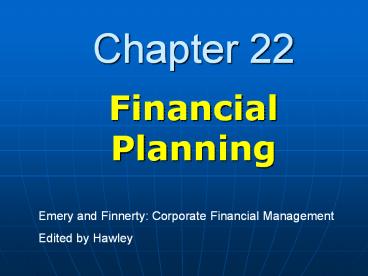Financial Planning - PowerPoint PPT Presentation
Title:
Financial Planning
Description:
Title: Chapter 22 Author: Anand Desai Description: See Notes to Slide # 16 for cash budgeting handout. Last modified by: DDH Created Date: 12/26/1996 3:27:56 PM – PowerPoint PPT presentation
Number of Views:142
Avg rating:3.0/5.0
Title: Financial Planning
1
Chapter 22
- Financial Planning
Emery and Finnerty Corporate Financial
Management Edited by Hawley
2
The Financial Planning Process
A firms financial plan involves decisions
about
- Liquidity
- Working Capital
- Inventories
- Capital Budgeting
- Capital Structure
- Dividends
3
The Financial Plan
- Financial planning is the process of evaluating
the impact of alternative investing and financing
decisions of the firm. - Every financial plan has three components
- A model
- Inputs
- Outputs
4
The Financial Plan
- The model is a set of mathematical relationships
between the inputs and the outputs. - Inputs to the model may include
- Projected sales
- Collections
- Costs
- Interest rates
- Exchange rates
5
The Financial Plan
- The outputs of the financial plan are
- Pro forma (projected) financial statements
- A set of budgets
6
Components of the Financial Plan
- Every financial plan should have
- Clearly stated strategic, operating and financial
objectives. - Assumptions on which the plan is based.
- Description of underlying strategies.
- Contingency plans to deal with the variances from
expectations.
7
Benefits of Financial Planning
- Future (strategic) orientation
- Identify and quantify assumptions
- Preparing for contingencies (risk analysis)
- Identify funding requirements
- Assess performance
8
Cash Budgets
- Cash budgets
- project and summarize cash inflows and outflows
- show monthly cash balances
- show any short-term borrowing needed to cover
cash shortfalls - Are based on sales forecasts.
- Are usually constructed on a monthly basis.
9
Preparing a Cash Budget
- Prepare a cash budget for Tyler Paints for the
months of April, May and June, given the
information in the handout.
10
Collections on Sales
- Collections in April are
- 20 of April Sales
- 45 of March Sales
- 35 of February Sales
- 20(1,200,000) 240,000
- 45(600,000) 270,000
- 35(500,000) 175,000
- 685,000
11
Collections on Sales
12
Collections on Sales
- Uncollected sales at the end of June (Accounts
Receivable) - 35(May Sales) (80 of June Sales)
- 35(1,000,000) 75(1,000,000)
- 1,100,000
13
Cash Disbursements
- Cash Disbursements in April
- Purchases of 60(May Sales)
- Wages of 20(April Sales)
- Other Fixed Expenses of 120,000
- 60(1,000,000)
- 20(1,200,000)
- 120,000
- 960,000
14
Cash Disbursements
15
Cash Budget
16
Cash Budget
- Tyler will have to borrow 225,000 in April.
- Tyler can repay 30,000 in May, leaving an
outstanding loan balance of 195,000. - The short-term loan can be fully repaid in June.
17
Cash Budget
- MODEL problem C-1 (linked on the web page) in a
spreadsheet, using input cells for the major
assumptions and good visual formatting
throughout. Check your solution against the one
provided on the class web page.
18
Pro Forma Financial Statements
- Pro Forma Statements
- Show the effect of the firms decisions on its
future financial statements. - Effects of alternative decisions and sensitivity
to changes in assumptions can be examined.
19
Percent of Sales Forecasting Method
- Assumes that some IS/BS items stay constant as a
percent of sales as sales vary. - In general, Accounts Receivable, Inventory,
Accounts Payable (on the balance sheet), and cost
of goods sold and some operating expenses (on the
income statement) vary with sales (maintain the
same percentage of sales) or cost of goods sold. - Other items are either fixed with respect to
changes in sales or they are plug figures.
20
Percent of Sales Forecasting Method
- Sales growth results in
- increase in current and fixed assets
- increase in spontaneous short-term financing
- increase in profitability
- The increase in current assets must be financed
from internally generated funds or external
funds. - Note WELL You can go BUST by letting GROWTH
outrun your CASH.
21
Percent of Sales Forecasting Method
- If internally generated funds are insufficient
to finance the growth, the firm may - Reduce the growth rate
- Sell assets not required to run the firm
- Obtain new external financing
- Reduce or stop paying cash dividends.
22
Additional Financing Needed (AFN)
- Let
- A/S the increase in assets per dollar increase
in sales. - L/S the increase in spontaneous liabilities
per dollar increase in sales. - S0 current level of sales.
- g projected growth rate in sales.
- M net profit margin on sales.
- D cash dividends planned for common stock.
23
Additional Financing Needed (AFN)
- Additional Financing Needed (AFN)
- Required increase in assets
- - Increase in (spontaneous) liabilities
- - Increase in retained earnings
- NOTE This a PERMANENT increase in the funding
requirement.
24
Additional Financing Needed (AFN)
- Additional Financing Needed (AFN)
- Required increase in assets
- - Increase in (spontaneous) liabilities
- - Increase in retained earnings
- AFN (A/S)gS0 - (L/S)gS0 - M(1g)S0 - D
- Note A/S, L/S, and AFN/g are NOT CONSTANTS and
MAY NOT BE LINEAR or CONTINUOUS.
25
Additional Financing Needed
- Peak Plastics expects rapid sales growth next
year. Sales for the current year were 4 million,
and are expected to grow by 20 next year. Peak
wants to estimate the external capital that will
be required to finance this growth. The firm
estimates that additional assets equal to 50 of
the increase in sales will be required.
Liabilities will increase by 18 of sales. The
net profit margin is 6 and Peak expects to pay
84,000 in dividends to its common stockholders.
26
Additional Financing Needed
(A/S)gS0 400,000 (L/S)gS0 144,000 M(1g)S0
- D 204,000 AFN 52,000
Do problems 5 and 6 in the Smart text































